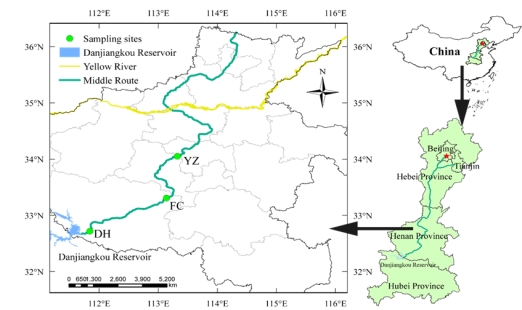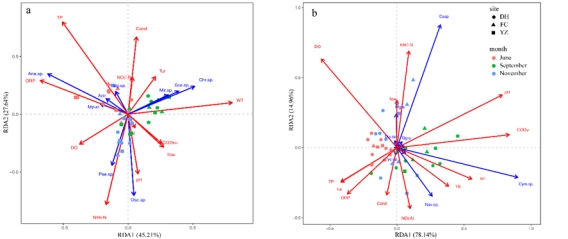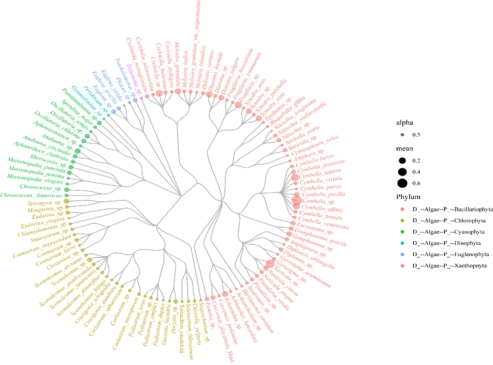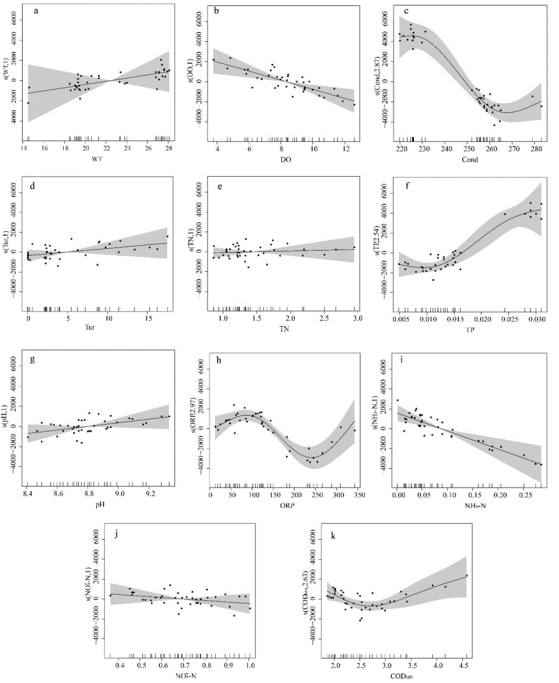Chen, X.; Wang, X.; Li, Y.; Yao, Y.; Zhang, Y.; Jiang, Y.; Lei, X.; Liu, H.; Wu, N.; Fohrer, N. Succession and Driving Factors of Periphytic Community in the Middle Route Project of South-to-North Water Division (Henan, China). Int. J. Environ. Res. Public Health 2022, 19, 4089. https://doi.org/10.3390/ ijerph19074089

第一作者:Xiaonuo Chen
通讯作者:Yuying Li
研究过程:着生藻对水环境变化十分敏感,其物种组成、数量和生物量对输水动态表现出明显的响应.为掌握人工干渠着生藻群落演替规律及其对水文调度和营养盐等环境因子的响应机制,分别于2019-2020年间6月、9月和11月6个时间段对干渠沿程3个典型生态渠段进行左右岸着生藻类群落特征和干渠水生态调查.

南水北调中线干渠沿线采样点分布
结果显示:着生藻类共有6门52属114种,其物种丰富度排序为硅藻(Bacillariophyta)>绿藻(Chlorophyta)>蓝藻(Cyanophyta),且秋季>夏季;优势类群包括桥弯藻(Cymbella sp.)、针杆藻(Synedra sp.)、舟形藻( Navicula sp.)、等片藻( Diatoma sp.)等;藻类丰度均值为3.24×105 ind./cm2,秋季藻类丰度高于夏季.
RDA与GAM模型分析显示:水温和营养盐是影响着生藻群落结构的关键因素,其次是流量和流速,这些因子成为干渠着生藻群落时空格局的决定因子.本研究确认了跨流域长距离输水的中线干渠河南段着生藻群落具有时空异质性;鉴于流速和流量对藻群落结构有影响,建议后期调水工程运行过程中可使用生态调度调控渠壁着生藻群落结构以保证输水安全.

南水北调中线干渠河南段着生藻群落与环境因子RDA排序(a) 蓝藻、绿藻和裸藻 (b)硅藻
研究结论:2019年6月—2020年11月南水北调中线干渠河南段共鉴定到着生藻类114个分类单位,隶属于6门31科114种(含变种).主要以硅藻为主,其次是绿藻和蓝藻.着生藻群落结构变化的时间效应比空间效应更加显著.

南水北调中线河南段着生藻类物种组成
RDA分析表明CODMn、pH、DO、WT和TP是对着生硅藻群落变化影响最为显著的主要环境因子.WT、TP、ORP和NH3-N是共同驱动蓝藻门、绿藻门着生藻群落演替的主要环境因子. GAM模型拟合了环境因子对着生藻生物量的响应机制,表明Cond、TP、NH3-N和ORP是主导南水北调中线干渠河南段着生藻生物量的主要因素.

环境因子对着生藻生物量影响的GAM模型示意
Succession and Driving Factors of Periphytic Community in the Middle Route Project of South-to-North Water Division (Henan, China)
Abstract: The Middle Route Project of the South-to-North Water Diversion is an artificially independent system that does not connect to other surface waters. Excessive periphyton proliferation causes a series of environmental problems in the canal. In this study, the periphyton community and environmental factors on the left and right banks of the canal in the algal growing area were investigated and sampled six times (June, September, and November of 2019 and 2020). The succession pattern of the attached organism community in the artificial canal was analyzed, and the key factors affecting the algal community were analyzed using RDA and GAM. The results showed that the seasonal variability of the environmental factors was more significant than the spatial variability. A total of 114 taxa of periphytic algae were found, belonging to seven phyla and 69 genera, and mainly composed of Bacillariophyta. Species richness was ranked as Bacillariophyta (60 taxa), Chlorophyta (31 taxa) and Cyanobacteria (15 taxa), and higher in autumn than in summer. The dominant taxa were Cymbella sp., Fragilaria sp., Navicula sp. and Diatoma sp. The abundance of periphytic algal varied from 0.07 × 105 to 8.99 × 105 ind./cm2, with trends similar to that of species richness. The redundancy analysis and generalized additive model showed that water temperature and nutrient concentration were the key factors influencing the structure of the algal community, followed by discharge rate and velocity, which were the determinants of the spatial and temporal patterns of the algal community. In view of the influence of discharge and velocity on the structure of algal communities, it is suggested that ecological scheduling could be used to regulate the structure of the algal community on the canal wall in the operation of later water division projects to ensure the safety of water division.
Keywords: periphytic algae; community structure; environmental factors; GAM